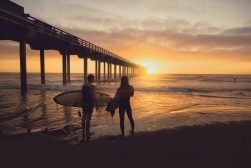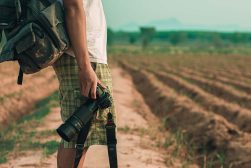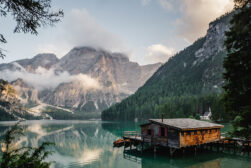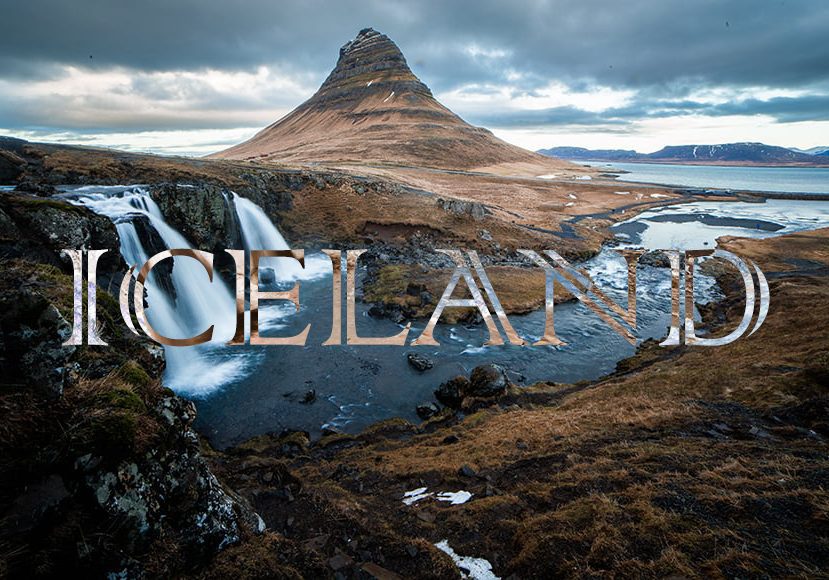
25 Best Iceland Landscape Photography Spots
Capture the most stunning shots of the Iceland landscape with this photography guide. Learn what to pack, how to prepare and how to stay safe.
Learn | Photo Locations | By Greg Cromie
In this guide to Iceland landscape photography, we’re going to cover all there is to know about planning a photography trip to this majestic and mysterious country.
Iceland is located at the edge of the Arctic Circle and spans an area of 103,000 square kilometres. Yet, despite its size, the population is only a little over 364,000 people.
It’s so sparsely populated that the density registers as 3 people per square kilometre. Most of the population lives in the capital of Reykjavik – the city you’re most likely to travel through on your journey.
As a result, the land is fertile with nature and mostly untouched by humanity. And you know what that means: It’s arguably the best place on the planet for landscape photography.
With glacier tongues, black sand dunes, the Vatnajökullice ice cap, the Golden Circle, lake Myvatn, Vatnajökull National Park, and everything in between, the Land of Ice and Fire is one photo tour that should be on your bucket list in 2024.
More local picture guides:
25 Best Iceland Landscape Photography Spots
If you’ve ever seen images and footage of Iceland, you’ll no doubt recall it to be like a setting from a fantasy novel or movie.
Iceland has often been referred to as the land of fire and ice (George RR Martin ring any bells?). It’s adopted this title thanks to its striking and untouched landscapes, wildlife and extreme geological events.
Active volcanoes, thermal activity, waterfalls, fjords, glaciers, lagoons and unique geographic features are abundant.
It’s the ideal location to stretch and explore your photographic skills – it’s also one of the most photographed places in the world.
Let’s take a look at the top 25 Icelandic destinations (in no particular order) for landscape photography.
1. Seljalandsfoss Waterfall

There are waterfalls dotted all over the Icelandic landscape, but Seljalandsfoss Waterfall is one of the most iconic.
The falls are located along the south coast of Iceland and bordered by an accessible pathway.
The falls drop from a 60-meter high outcropping that you can get behind to frame a gorgeous landscape composition.
2. Stampahraun Lava Field

Stampahraun is situated on the tip of the southern peninsula of Iceland and sits 27 meters above sea level. What’s more, it’s located relatively close to the capital.
The terrain is bleak, treacherous and covered in black volcanic rock. The resulting landscape photography captures an alien-like world in all lighting conditions.
3. Diamond Beach
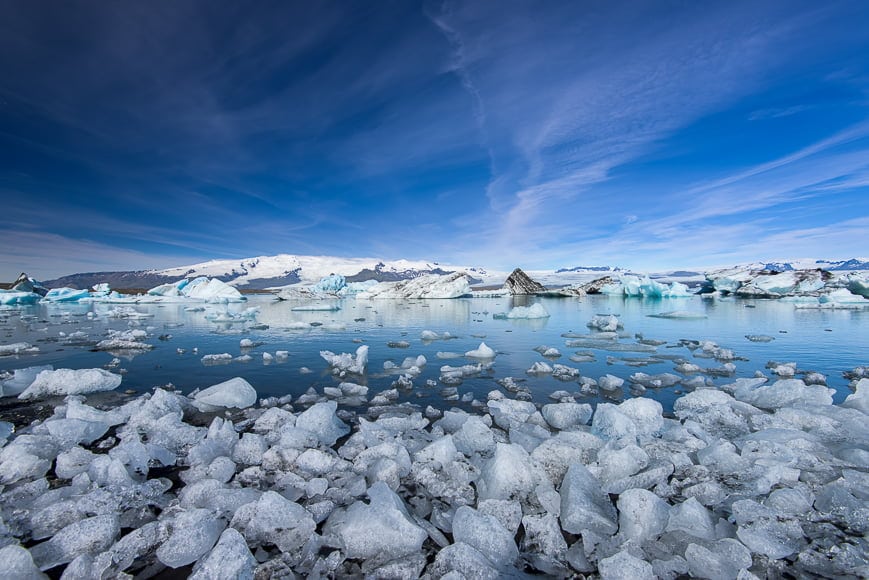
Diamond Beach sits at the edge of the Breiðamerkursandur glacial plain and stretches 18 kilometres along the south coast of Iceland.
Black sand creates a stark contrast against the unique ice formations that scatter along the beach. They reach from the foot of the Kvíárjökull Glacier, making for amazing backdrops.
If you’re lucky, the beach will also be occupied by local wildlife such as seals and orcas.
4. Gullfoss Falls
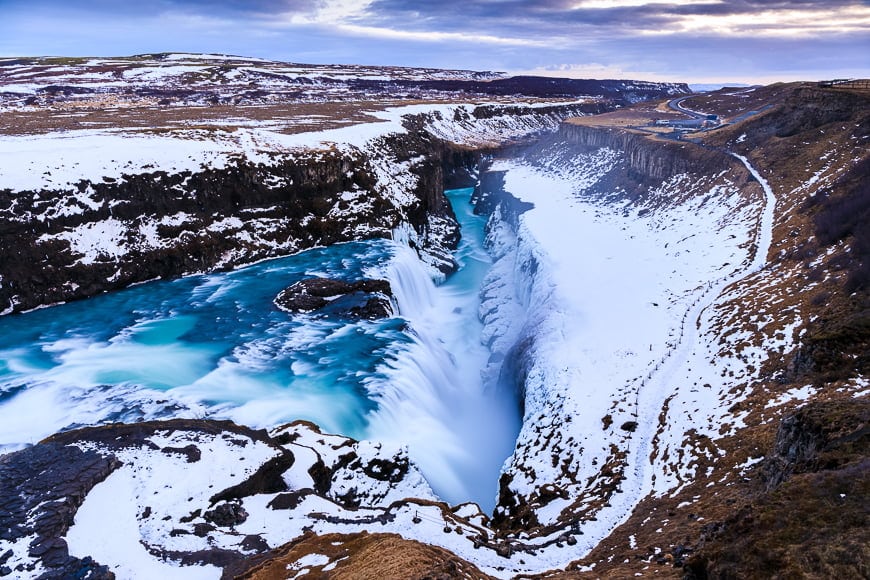
Gullfoss Falls, or Golden Falls, are created by a breathtaking crevice formed in the earth. At the peak of summer and with the right light, the falling water and resulting spray create a golden glow.
There are many vantage points to photograph the falls, with one in particular allowing for dramatic images of water pouring into the earth.
How Much Do You REALLY Know About Photography?! 🤔
Test your photography knowledge with this quick quiz!
See how much you really know about photography...

The location is accessible via a hiking track with plenty of wildlife to witness along the way.
5. Reynisfjara & Reynisdrangar

Reynisfjara is a long stretch of black sand beach and is ideal for moody landscape photography. The beach is considered one of the most beautiful in the world.
On brighter days, you can observe the giant sea stacks known as Reynisdrangar – a formation of large basalt sea stacks close enough to the beach for stunning photos.
6. Kirkjufell

One of the most visually inspiring sites for landscape photography is Mount Kirkjufell. Located on the Snæfellsnes Peninsula, it’s one of the countries most photographed mountains.
Kirkjufell is 463-meters above sea level and has a pyramid-shaped peak. A great time to photograph this stunning monolith is during the midnight sun of winter.
7. Sólheimasandur
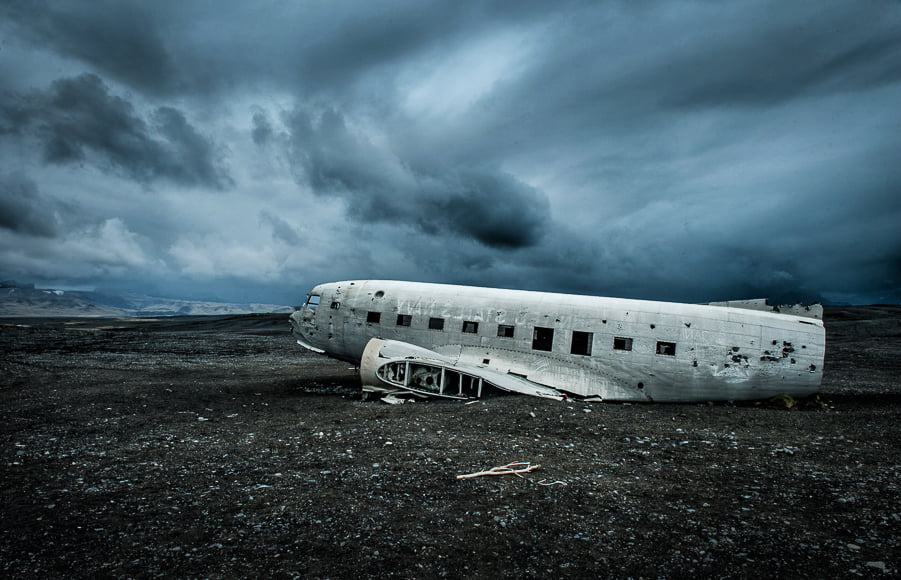
Sólheimasandur has appeared in countless images and documentaries due to its barren landscape an abandoned wreck of a plane standing guard over the land.
The plane is a US Navy Douglas Super DC-3 that crashed in 1973 due to the icy conditions. It’s those same conditions that keep the wreckage preserved for all time.
8. Skógafoss
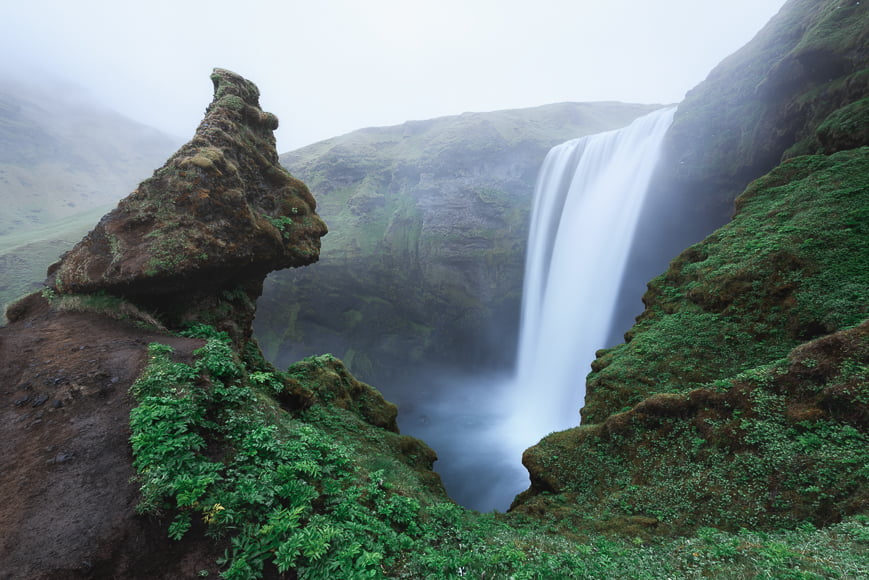
Skógafoss is a sight to behold as one of Iceland’s biggest waterfalls. The powerful force of water drops from 62 metres and at a width of 25 metres.
While you can reach out to touch the water, it’s power will push you back and drench you. The resulting spray is cast wide, allowing for stunning rainbows to form in the sunlight.
Photographing this site from any angle and any distance will deliver incredible images.
9. Sun Voyager
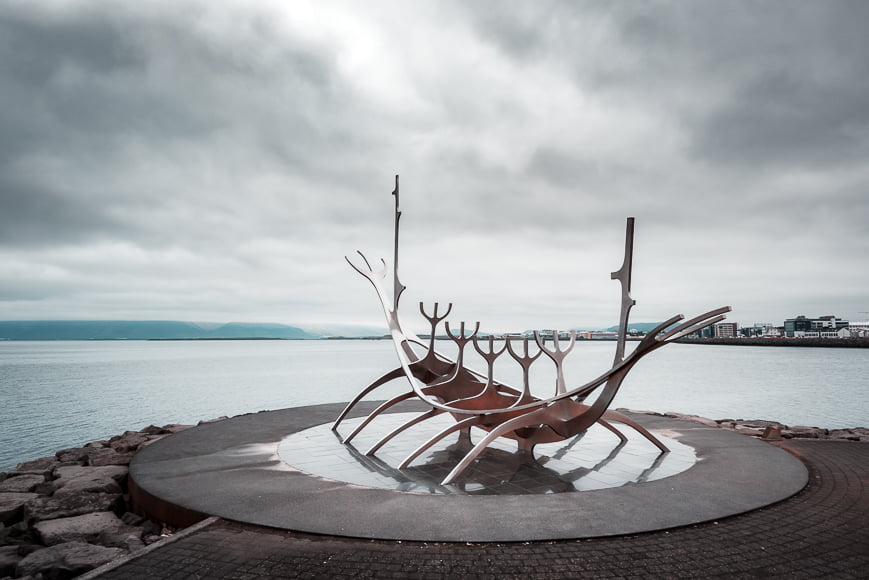
Iceland has a profound history due to being settled by Viking explorers. To celebrate and symbolise this history, an Icelandic sculptor created the Sun Voyager – a stylised form of a ship that was built to honour the sun.
The scupture makes for an exciting backdrop to a sunset or sunrise photo.
10. Gunnuhver Hot Springs

Gunnuhver is an active geothermal region of boiling steam vents and mud pools. Minerals have been pushed up from the earth’s depths to create vibrant colours in both the mud and the gas vents.
Photographing such a scene will no doubt create incredible images of a pre-historic landscape.
11. Fjaðrárgljúfur Canyon

Iceland has some genuinely awe-inspiring chains of canyons with a stand out being Fjaðrárgljúfur.
Tourism has more recently resulted in the canyon being closed off due to environmental damage.
Fortunately, you can still get close enough to capture stunning images of black-walled canyons covered in lush green vegetation – keep your eyes open for natural s curves to elevate your photography.
12. Krísuvík Cliffs
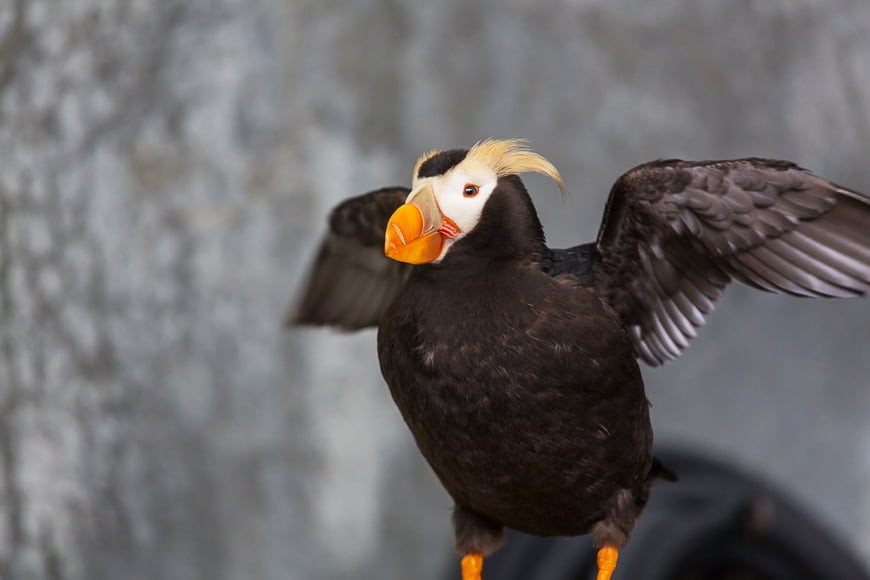
Krísuvík is home to thousands of sea birds and nests. The spot is accessible via a hiking path and provides wildlife photographers with ample opportunity to capture images of bird species.
13. Blue Lagoon

Credit: Frank Denney
Blue Lagoon is a geothermal spa located close to the capital of Reykjavík. The area is a popular destination for locals and tourists who flock to the natural wonder.
The lagoon is crystal clear and thanks to the mineral-rich waters, project a blue glow. While the temptation to get in the water beckons, photographing the location will deliver fantastic outcomes.
14. The Berserkjahraun Lava Field

With scenery ranging from rocks blanketed by green moss to blackened lava hills, this is a perfect destination to capture Iceland’s stark contrasts.
The field pens in twin lakes that create a beautiful landscape worth the hike.
15. Hallgrimskirkja Church
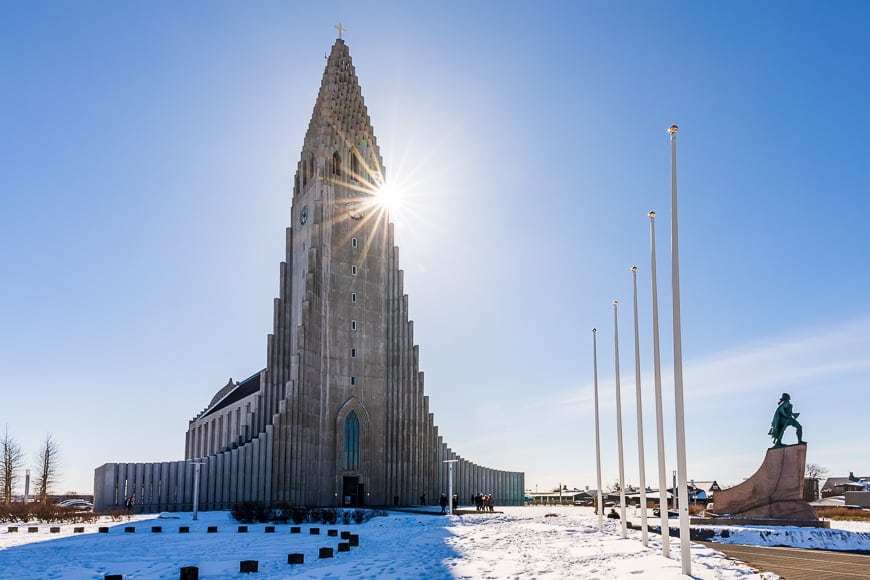
Hallgrimskirkja Church is a Lutheran parish standing at 74.5 meters and is the tallest building in Reykjavik. It’s located atop Skólavörðuholt hill and appears to tower over the city.
If it’s location and stature aren’t enough, the building is a beautiful and unusual symmetrical structure that took 41 years to build.
16. Geysir Hot Spring
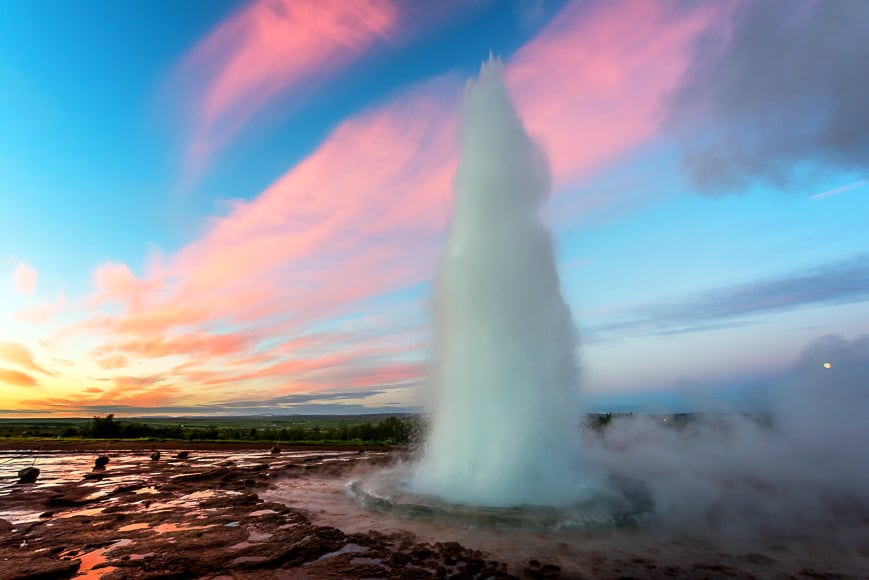
Geysir is a key destination along the tourist route of Haukafalur Valley.
The hot spring is very active, and every ten minutes will pulse a steaming hot gush of water 30-meters into the air.
The whole area is dotted with hot springs and geothermal steam vents, setting an idyllic scene for landscape photographers.
17. Thórsmörk

For the Marvel Avengers fans, Thórsmörk is a mountain ridge named after Thor, the god of thunder. He’s not just a super-hero but a real-life God!
The location is a vast valley surrounding by lush volcanic cliffs and mountains. From the right spot and elevation, the view is astounding and well worth a photo or two.
18. Jökulsárlón Glacier Lagoon
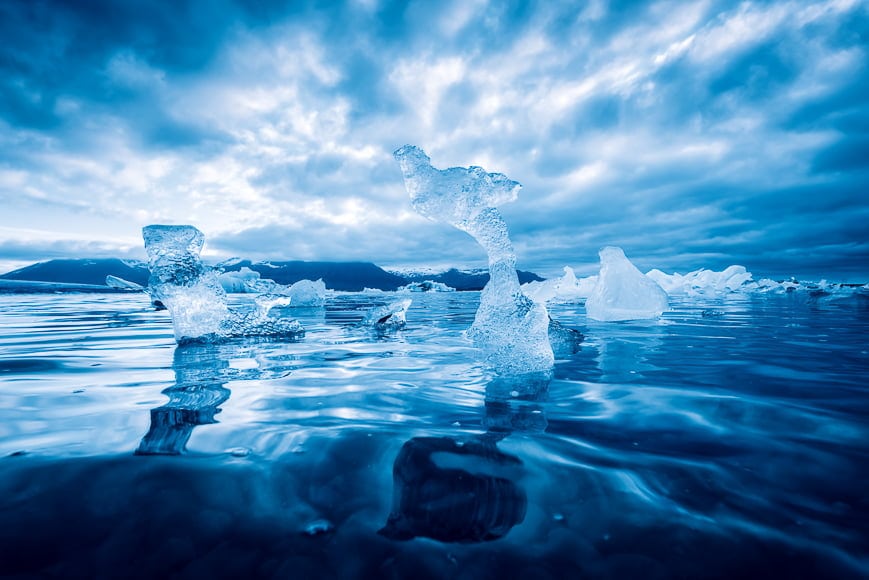
Jökulsárlón is one of the most beautiful natural sites in all of Iceland. Positioned next to Vatnajökull, the largest glacier in Iceland and all of Europe, it’s vast beauty could take days to explore.
The lagoon and surrounds feature glacial tongues spilling into the waters, giant chunks of ice, mountainous surrounds and dazzling clear water.
You can even take advantage of the local boat tours to photograph these natural elements.
19. Djúpalónssandur Beach

Djúpalónssandur Beach is a black pebbly beach dotted with tall lava formations. A brilliant foreground element to your landscape shots is the rusted hull of a shipwreck scattered across the scene.
The area is completely deserted other than the sea bird life dotting the scenery.
20. Mývatn Lake & Northern Lights
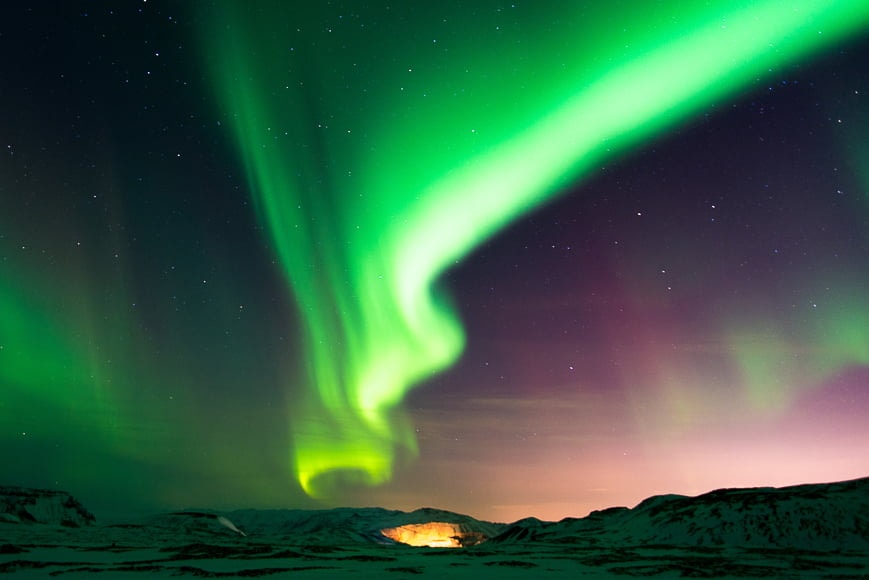
Mývatn is a shallow lake with a bright blue hue sitting in the middle of an active volcanic landscape. The surrounds are dotted with evidence of recent and historical volcanic eruptions.
What’s more, Mývatn is considered an ideal location for Northern Lights photography, aka the Aurora Borealis.
This phenomenon appears as dancing blue and green lights formed when electronically charged particles from the sun collide with atoms and particles within the earth’s atmosphere.
It’s pure magic and best seen from November to March!
21. Breiðamerkurjökull Glacier Ice Cave
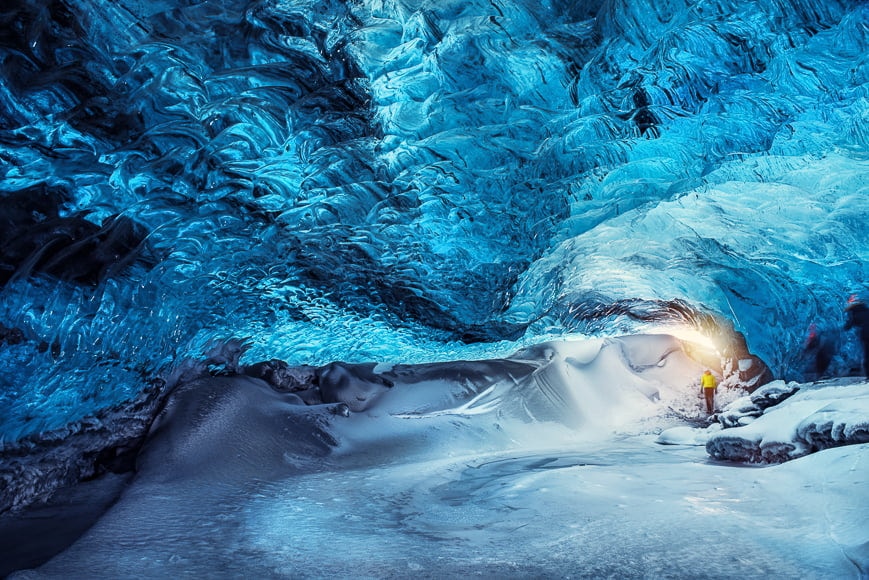
The Breiðamerkurjökull Glacier Ice Cave is one of the most incredible sites to behold. With the retreating glacier, giant cracks have formed in the ice. In turn, this has caused a natural giant cave to form.
The interior is an ideal location for incredible images due to the glowing walls and glistening floor.
22. Hvítserkur

Hvítserkur is an oddly formed sea stack that stands 15 meters tall and sits just off the coast. It makes for an exciting element in a landscape shot and is sometimes accessible by foot during low tide.
It’s often referred to as the Troll of Northwest Iceland thanks to its hulking three-legged shape.
Incidentally, warm ocean currents which come from the Atlantic Ocean including the Gulf Stream, are the reason why the sea around Iceland doesn’t freeze.
23. Landmannalaugar

Landmannalaugar mountain range offers a very unique and strangely colourful landscape located in the Fjallabak Nature Reserve.
The lushness of the valleys and the coloured tops and flanks of the mountains form an exciting contrast.
Landscape photographers can spend hours hiking and photographing this lava field tundra.
24. Kleifarvatn Lake

Kleifarvatn is the largest body of water in the Reykjanes Peninsula. You can navigate the lake thanks to a reliable walking track. This allows you to enjoy and capture stunning landscape images of the region.
One of the best times to visit this area is during the summer months due to the warmer temperatures and midnight sun.
25. Goðafoss Waterfall

Goðafoss, or Waterfall of the Gods as it’s otherwise known, is one of the most significant falls in Iceland. It’s said that every Norse God Idol was thrown into its waters when Iceland converted to Christianity.
It provides a fantastic centrepiece for landscape shots as the falls are 12 meters high and over 30 meters wide. This also makes a significant element in Northern Lights photography.
What is the Landscape Like in Iceland?
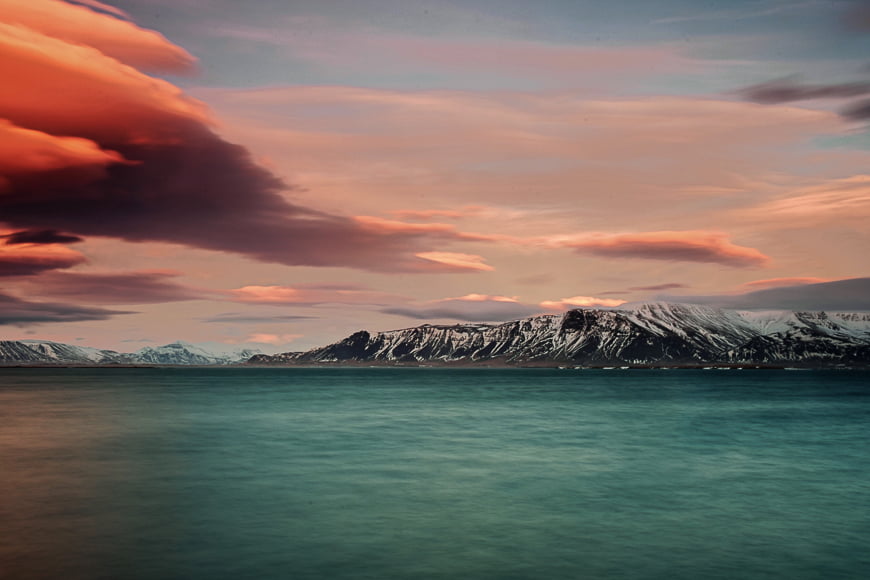
As we’ve discovered, Iceland is home to some of the most astonishing and unique landscapes in the world. The blend of mountains, tundras, beaches, glaciers, fjords, volcanoes and waterfalls form an otherworldly terrain that has to be seen to be believed.
Freezing glaciers and icy plains clash with contrasting lava fields and volcanic mountains. Waterfalls distract your view from lush valleys and colourful mountain ranges. Photogenic fishing villages pepper the coast.
You could almost blindly point your camera in a random direction and be guaranteed a stunning shot. Plus, you could easily experience a black pebbled beach, a frozen glacier underfoot and a craggy volcanic plain all in the same day.
The scale of Iceland and lack of human habitation makes all of these incredible destinations accessible. While most sites can be reached by car, others will require alternative transport, with hiking being the most popular.
What is unique about islands like Iceland is that its geography makes landscape photography both fascinating and achievable.
One of the critical elements that impacts the look and feel of Iceland and its landscapes is the seasons. The weather in Iceland can change within minutes as too can the lighting conditions.
Due to its location in the arctic circle, the daylight hours alter drastically depending on the time of the year. From late May to the end of July, the sun rarely sets but instead skims across the horizon. At other times, darkness prevails, and there are only around five hours of daylight per day.
These unique conditions make for fascinating effects on the landscape and the moods that you can photograph.
How to Prepare for the Iceland Landscape

Camera gear of Iceland workshop host Jens Klettenheimer on Shotkit
A trip to Iceland is like no other photographic adventure.
It’s not like throwing a few lenses into a bag and taking a trip to a local beach. There’s a lot of essential planning that you must undertake to ensure that you have the right gear, clothing and knowledge to make the most of the opportunity.
Poor preparation could easily ruin a once in a lifetime experience photographing the Icelandic landscape.
-
Camera Gear Preparations
Let’s start with the obvious, and some would argue most important: your camera gear.
First and foremost, you’re going to need a reliable and durable camera body. You may be doing quite a bit of hiking and even some cross country travel, so having a robust camera will ensure it doesn’t get damaged.
What’s more, you’ll likely experience some cold conditions, so having a camera that’s weather-sealed and can withstand freezing temperatures is a must.
As you’ll likely be shooting in RAW format, be sure to pack ample memory cards and have a system in place to store, protect and organise them. You don’t want to lose or write-over a card you’ve already filled up.
The same applies to batteries as well as packing a decent power bank to charge your camera and other devices on the go.
As for lenses, I’d recommend going with a couple of versatile zooms. Of course, it’s going to depend on what you’re shooting, but being in Iceland is probably going to make you want to photograph everything.
A landscape zoom with a wide-angle is a good start followed by a decent telephoto zoom up to 200 or 300mm. As you’ll be carrying and often hiking with your gear, if you go overboard with lenses you may live to regret it.
I would also recommend ensuring you pack some ND filters or a variable version. In addition to this, I would strongly advise investing in a robust carbon-fibre travel tripod for long exposure work too.
The last thing on the list is a camera backpack that’s durable and weather resistant. It needs to carry your camera gear and possibly some safety gear.
-
Clothing Preparations
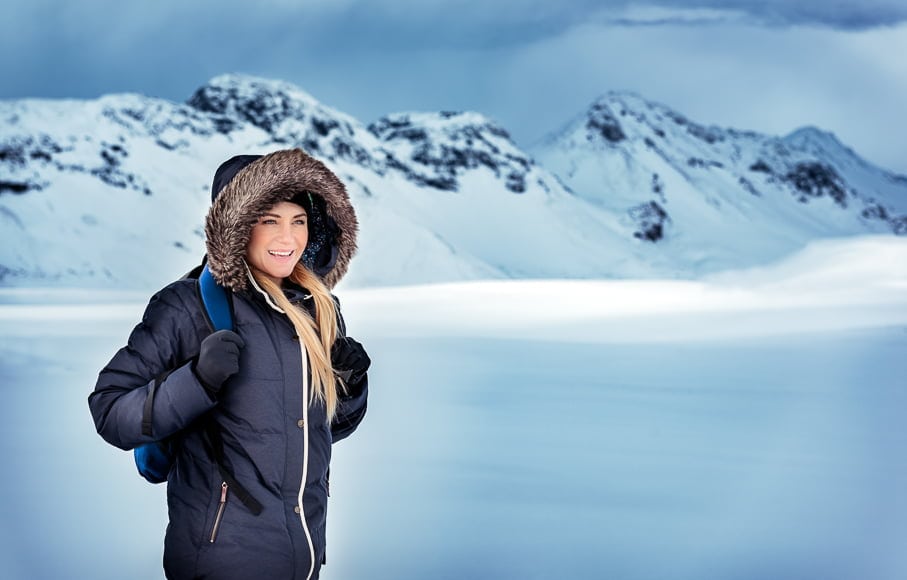
The very top of the list for preparing and packing for Iceland is going to be your footwear.
There’s no point getting halfway through day one of your adventure only to find that your shoes are wet, uncomfortable and relatively useless in the Icelandic landscape.
Visit a quality camping store and talk to the staff about footwear solutions for the kinds of terrain you will encounter.
You’re going to need shoes that will stand up to long days on foot as well as being comfortable and waterproof. Well before your trip, wear them around to break them in, so they’re comfortable by the time you travel.
Iceland is at the edge of the Arctic Circle, so you only have yourself to blame if you get cold.
Prepare for this by purchasing thermal layers and a quality jacket specifically designed to meet the kinds of temperatures you’ll experience.
And like boots, if you don’t get suitable quality gloves, then you’re going to suffer. Try on everything along with your camera gear before you even board a flight.
-
Safety Preparations
Before we wrap up with my final thoughts, I wanted to cover some essential safety considerations for travels to Iceland.
Despite its natural and unbeatable beauty, Iceland can be an inhospitable place.
Here are a few things to consider to ensure your safety:
- Know Iceland’s emergency contact phone numbers and organise a local SIM before you travel or when you arrive.
- Keep a constant eye on the weather forecast as it changes rapidly.
- Research roads you’ll go on and learn how the weather impacts them.
- Geothermal activity is mesmerising but dangerous – stick to the path and follow the guides.
- Let people know where you’re heading – local police, hotel management, friends.
- Use safetravel.is to do your travel research and even submit a travel plan.
Iceland Photography | Final Thoughts
Travelling to Iceland on a photographic adventure is a once in a lifetime experience. You’ll be overcome with the sheer volume of landscape choices available.
The astounding beauty and environment of Iceland are like no other place on earth. With a camera in hand, you too can capture all that this fantastic island has in store.
Happy travels!

Check out these 8 essential tools to help you succeed as a professional photographer.
Includes limited-time discounts.





